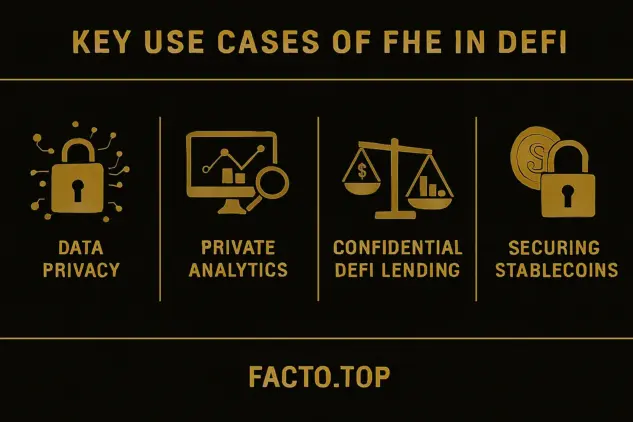Fully Homomorphic Encryption (FHE) in DeFi
Fully Homomorphic Encryption (FHE) in DeFi: Unlocking Privacy and Scalability
Building the Next Generation of Private Smart Contracts and Confidential Finance
In the rapidly evolving world of decentralized finance (DeFi), privacy and scalability are no longer optional—they are critical engineering requirements. Traditional blockchains, built on transparency, expose every transaction detail—a fatal flaw that fuels front-running (MEV), complicates regulatory compliance, and freezes out enterprise adoption. The solution is clear: computations must happen on encrypted data.
Fully Homomorphic Encryption (FHE) is the cryptographic method poised to solve this. FHE allows dApps to perform complex operations on ciphertexts without ever decrypting them. This groundbreaking property is the key to deploying truly private smart contracts and confidential financial operations across Ethereum and Layer 2 protocols.
Privacy Solutions in DeFi
The urgent need for confidentiality in decentralized finance has driven the industry toward powerful cryptographic solutions. While the current transparency of public ledgers enables auditability, it simultaneously exposes users to fatal risks, primarily Maximal Extractable Value (MEV) and front-running. True Privacy Solutions in DeFi demand a paradigm shift, moving beyond basic mixers and requiring computation on encrypted data. Fully Homomorphic Encryption (FHE) is emerging as the definitive answer, as it directly solves the “plaintext problem.” However, FHE is often deployed not in isolation, but as part of hybrid architectures, combined with Zero-Knowledge Proofs (ZKP) for fast verification and Multi-Party Computation (MPC) for distributed trust. These combined protocols allow the ecosystem to deliver the best of both worlds: verifiable computation and absolute data confidentiality.
Understanding FHE: Computation on Encrypted Data
FHE enables arbitrary computations directly on encrypted inputs. When the encrypted output is finally decrypted, the result is mathematically identical to performing the operation on the original plaintext.

This is why FHE is mandatory for advanced privacy-preserving DeFi applications, allowing sensitive user data—balances, trade flows, and positions—to be processed entirely off the public ledger’s view. This fundamentally changes the security model of a decentralized application (dApp).
Encrypted Computation Workflow for FHE in DeFi
FHE integrates into DeFi through a specialized, multi-step process, essential for ensuring both confidentiality and efficiency. This workflow illustrates how FHE enables computations on encrypted data, from user input to final on-chain verification, keeping all sensitive information private.
| Step | Description | Key Function | Notes |
|---|---|---|---|
| 1. User Data Encryption | User encrypts sensitive data (balances, orders, NFT ownership) locally using FHE keys. | Confidentiality enforced | Data remains private before submission to the blockchain or L2. |
| 2. Off-Chain FHE Computation | Smart contract logic or dApp processes the encrypted data (ciphertext) without decryption using FHE operations. | Private smart contracts | Can include lending, borrowing calculations, NFT transfers, or DAO voting logic. |
| 3. Bundler / Aggregator Submission | Encrypted UserOperations are batched and submitted to Layer 2 for efficiency. | Gas Optimization | Ensures batching, gas optimization, and reduces transaction costs. |
| 4. On-Chain Verification | Smart contracts verify the correctness of encrypted operations using FHE properties or Zero-Knowledge Proofs (ZKP). | Prevents Front-Running | Anchors security to L1 while preserving transaction privacy. This step requires specialized cryptographic validation. |
| 5. Decryption (Optional) | User or authorized party decrypts the final result (e.g., updated balance, counted vote). | Final Outcome | Only authorized entities can decrypt the result. This final step confirms the integrity of the computation. |
Developer Action: To overcome the performance challenges, combine FHE in DeFi with Layer 2 scaling and off-chain MPC/ZK aggregation. This hybrid approach is the only way to deliver both high privacy and acceptable latency for a decentralized system.
FHE Advantages vs. Performance Challenges
While FHE offers game-changing security, its computational cost dictates trade-offs that developers must manage proactively. Understanding these constraints is vital for the successful implementation of any homomorphic encryption scheme.
Core Advantages for Next-Gen DeFi
- Data Privacy & Confidentiality: Users transact without revealing account balances or sensitive trading strategies, protecting them from surveillance and data leakage.
- MEV/Front-Running Resistance: Execution of contract logic on encrypted data makes pre-emptive sniping and malicious extraction impossible, creating a fair execution environment.
- Regulatory Compliance: FHE enables confidential reporting and auditing processes, making compliance with strict regulations like GDPR and BIPA achievable in a decentralized context without exposing plaintext data to the public.
- Hybrid Use Cases: FHE combines seamlessly with MPC (Multi-Party Computation) and ZK-proofs for enhanced efficiency and performance, creating robust cryptographic protocols.
| Aspect | Traditional Smart Contracts | FHE-Enabled Smart Contracts | Impact |
|---|---|---|---|
| Data Privacy | Public on-chain | Fully encrypted | Mandatory for confidential finance. |
| Security Against Front-Running | Highly Susceptible | Fundamentally Resistant | Eliminates MEV profit vector. |
| Computation Speed | Fast, native execution | Slower due to ciphertext operations | Requires Layer 2 optimization. |
The Production Hurdles: Performance and Tooling
The move to production is slowed by three core issues related to the inherent complexity of FHE cryptography. Addressing these challenges requires strategic planning and advanced cryptographic engineering.
- Performance Overhead: FHE operations are computationally expensive, often orders of magnitude slower than plaintext computations. This is the single biggest impediment to real-time FHE in DeFi adoption. The overhead necessitates careful design, especially for high-frequency or complex mathematical tasks like those found in decentralized exchanges (DEX).
- EVM Integration Complexity: Existing Ethereum Virtual Machine (EVM) smart contracts and L2 solutions are not natively optimized for encrypted computation. This means developers must build complex off-chain services, or computation bridges, to handle the FHE heavy lifting before submitting minimal verification data back on-chain. This introduces new points of failure that require strict monitoring.
- UX Implications: Increased transaction latency and elevated gas consumption stemming from the overhead can significantly create user friction for time-sensitive operations like trading or NFT transfers. Developers must manage user expectations and provide solutions like gas sponsorship or pre-signed operations to maintain a smooth user experience (UX).
- Tooling Limitations: The FHE ecosystem is young. Few mature, production-ready libraries exist that offer seamless integration with common smart contract languages like Solidity, Vyper, or Rust. Building a reliable FHE application often requires deep cryptographic knowledge, limiting the pool of developers capable of building the next wave of confidential dApps.
Key Use Cases of FHE in DeFi
FHE’s utility extends across DeFi’s most complex and vulnerable sectors, fundamentally reshaping how we approach decentralized privacy.

Encrypted Lending and Private Asset Transfers
FHE allows transfers of assets and complex logic execution without revealing the sender’s or recipient’s balances on-chain. DeFi lending protocols can process collateral and dynamic interest rates on encrypted data, keeping sensitive financial metrics private. This is particularly useful for high-value NFT marketplaces where preserving anonymity and preventing snipe attacks is critical. Encrypted computation enables risk assessment without exposing portfolio size.
| Use Case | Core Benefit | Implementation Strategy |
|---|---|---|
| Encrypted Lending & Borrowing | Compute collateral and rates without revealing user data, enhancing financial privacy. | Combine FHE with batching and Layer 2 scaling to manage computational load. |
| Private NFT Trading | Enable lazy minting, delegated transfers, and gasless approvals on encrypted ownership state, creating confidential marketplaces. | Use hybrid FHE + off-chain signature aggregation for UX speed. |
| Confidential DAO Governance | Encrypted voting and proposals to prevent vote leakage or manipulation, strengthening decentralized governance. | Combine FHE with ZK-proofs for secure result validation, reducing the governance attack surface. |
| Private DEX Aggregation | Allow users to submit encrypted swap orders, mitigating slippage and front-running on decentralized exchanges. | Use FHE to compute the optimal route on private inputs, maintaining trade confidentiality. |
FHE Deployment: The Developer’s Playbook and Q&A
For developers looking to leverage FHE for DeFi, a strategic, performance-first approach is vital to manage complexity and cost. Mastering the principles of advanced cryptography is the key to success.
Key Optimization Strategies (The Speed vs. Privacy Balance)
- Adopt Hybrid Architectures: This is non-negotiable. Use FHE for the logic that requires privacy, and utilize MPC or ZK-proofs for faster verification and aggregation steps. This is critical for achieving cryptographic efficiency.
- Master Gas and Latency: The high cost of ciphertext processing must be managed by batching encrypted operations and deploying exclusively on high-throughput Layer 2 solutions. Careful resource management is crucial here.
- Leverage the Ecosystem: Start with established, robust FHE frameworks like Zama’s Concrete, Microsoft SEAL, or TFHE. These accelerate development by handling the core cryptography.
- Compliance Documentation: FHE aids compliance. Document how your encryption protocols satisfy privacy mandates like GDPR by ensuring sensitive data is never stored in plaintext. Perform regular code audits.
FHE Implementation: Key Takeaways
FHE is the key technology that allows DeFi to mature beyond simple transparent ledger operations. The future of private smart contracts demands informed caution and strategic engineering. The development lifecycle for confidential computing differs significantly from traditional blockchain development.
| Quick Wins for Developers | Common Pitfalls to Avoid |
|---|---|
| Experiment with small-scale FHE demos on Ethereum L2 or specialized FHE networks. | Overloading users with complex encrypted flows without adequate guidance. |
| Batch operations and provide gas sponsorship to simplify UX, improving user adoption. | Ignoring gas optimization—encrypted operations can be extremely costly. |
| Use visual UI feedback to explain encrypted operations and manage latency expectations. | Neglecting audit and monitoring—privacy isn’t worth a hack. |
| Leverage community libraries like Zama’s Concrete or Microsoft SEAL for rapid prototype development. | Trying to do everything on-chain; hybrid off-chain + FHE is always smarter and more scalable. |
The shift ensures the future of DeFi is not just decentralized, but also truly confidential. Start small, test everything, and scale smartly.
Disclaimer
This article is for educational and analytical purposes only and does not constitute financial, legal, or technical advice. FHE implementations in DeFi carry significant risks, including computation overhead, latency, gas costs, and potential security vulnerabilities. Developers must thoroughly test, audit, and monitor all production deployments.
